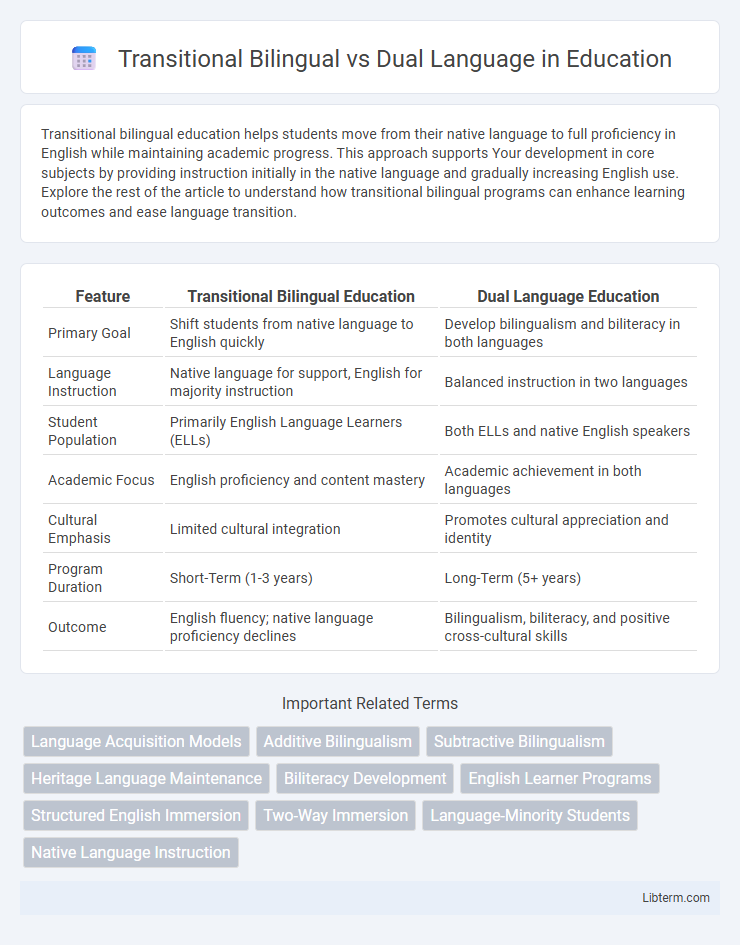Transitional bilingual education helps students move from their native language to full proficiency in English while maintaining academic progress. This approach supports Your development in core subjects by providing instruction initially in the native language and gradually increasing English use. Explore the rest of the article to understand how transitional bilingual programs can enhance learning outcomes and ease language transition.
Table of Comparison
| Feature | Transitional Bilingual Education | Dual Language Education |
|---|---|---|
| Primary Goal | Shift students from native language to English quickly | Develop bilingualism and biliteracy in both languages |
| Language Instruction | Native language for support, English for majority instruction | Balanced instruction in two languages |
| Student Population | Primarily English Language Learners (ELLs) | Both ELLs and native English speakers |
| Academic Focus | English proficiency and content mastery | Academic achievement in both languages |
| Cultural Emphasis | Limited cultural integration | Promotes cultural appreciation and identity |
| Program Duration | Short-Term (1-3 years) | Long-Term (5+ years) |
| Outcome | English fluency; native language proficiency declines | Bilingualism, biliteracy, and positive cross-cultural skills |
Understanding Transitional Bilingual and Dual Language Programs
Transitional Bilingual programs aim to transition students from their native language to English proficiency by gradually increasing English instruction while maintaining support in the first language. Dual Language programs develop bilingualism and biliteracy by providing balanced instruction in both the native language and English, promoting academic achievement in both languages. Understanding the differences involves recognizing that Transitional Bilingual focuses on English acquisition, whereas Dual Language fosters long-term bilingual development.
Key Differences Between Transitional Bilingual and Dual Language Approaches
Transitional bilingual programs aim to shift students from their native language to English quickly, focusing on English proficiency and phasing out the first language. Dual language programs promote bilingualism and biliteracy by teaching academic content in both languages, supporting long-term language development and cultural competence. Key differences include the duration of native language use, with transitional programs limiting it, while dual language programs maintain and develop two languages simultaneously for all students.
Core Objectives of Transitional Bilingual Education
The core objectives of Transitional Bilingual Education prioritize helping students achieve English proficiency while maintaining native language skills, aiming for a smooth transition into mainstream English-only classrooms. Instruction is primarily in the student's native language initially, gradually shifting to English to ensure content comprehension and academic success. This model emphasizes rapid development of English while supporting cognitive and linguistic foundations through native language use.
Fundamental Goals of Dual Language Programs
Dual language programs aim to develop bilingualism, biliteracy, academic achievement, and cross-cultural competencies in both English and the partner language, fostering additive language development. Unlike transitional bilingual programs that focus on English proficiency and eventual English-only instruction, dual language education promotes proficiency and literacy in two languages for all students. This approach supports long-term cognitive, social, and academic benefits by maintaining and enriching native language skills while acquiring English.
Language Development Strategies in Both Models
Transitional bilingual programs emphasize rapid English proficiency by initially using students' native language for instruction before shifting predominantly to English, utilizing strategies such as scaffolded language support and content-based ESL. Dual language models promote bilingualism and biliteracy by integrating native English speakers and language minority students in the same classroom, employing strategies like balanced language exposure and cooperative learning to develop proficiency in both languages simultaneously. Both models use differentiated instruction and culturally relevant materials to support language acquisition but differ in their long-term goals: English dominance in transitional bilingual versus bilingual competence in dual language programs.
Student Demographics and Enrollment Criteria
Transitional bilingual programs primarily serve English Language Learners (ELLs) aiming to transition to English-only instruction, often targeting students with limited English proficiency and recent immigrant backgrounds. Dual language programs enroll both native English speakers and ELLs to promote bilingualism and biliteracy, typically requiring voluntary participation and willingness to develop proficiency in two languages. Enrollment in transitional bilingual education is often based on language proficiency assessments, while dual language programs emphasize a balanced demographic mix to foster cross-linguistic interaction.
Academic Outcomes: Comparing Success Rates
Transitional bilingual programs often show lower academic outcomes compared to dual language programs, which promote bilingualism and biliteracy by integrating native and English speakers. Studies indicate that students in dual language programs outperform their peers in transitional bilingual settings on standardized tests in reading and math. Dual language models foster higher English proficiency and academic achievement, contributing to long-term educational success.
Cultural Integration and Community Involvement
Transitional bilingual programs primarily focus on moving students quickly from their native language to English, often limiting cultural integration by prioritizing English proficiency over maintaining the student's home language and cultural identity. Dual language programs emphasize bilingualism and biliteracy, promoting cultural integration by valuing both languages and fostering mutual respect among diverse communities. Community involvement in dual language programs tends to be stronger as families from different linguistic backgrounds collaborate, enhancing cultural exchange and support.
Teacher Preparation and Program Implementation
Teacher preparation for transitional bilingual programs emphasizes strategies for rapidly shifting students from their native language to English, focusing on targeted language acquisition skills and cultural responsiveness. In contrast, dual language programs require educators to be proficient in both languages and trained in biliteracy development, fostering balanced instruction and long-term bilingualism. Program implementation in transitional bilingual settings centers on accelerating English proficiency, while dual language models organize curriculum to support academic content mastery in both languages simultaneously, promoting additive bilingualism.
Choosing the Right Program for Your School or District
Choosing between Transitional Bilingual and Dual Language programs depends on your school's goals for language proficiency and cultural competency. Transitional Bilingual programs support English learners by gradually shifting instruction to English, aiming for English fluency and mainstream integration. Dual Language programs promote bilingualism by teaching content in both languages simultaneously, fostering biliteracy, cross-cultural understanding, and long-term academic achievement.
Transitional Bilingual Infographic

 libterm.com
libterm.com